CyI researchers participate in important Morocco archaeological project (pics)
12:54 - 17 January 2024

CyI researchers from STARC’s Archaeological Science group are participating in an important project to unravel the technology of silver, copper and brass production in medieval Morocco.
At the centre of the research is deciphering the ancient technology behind silver production, via analysis of ore remains, furnace wall fragments, and the glassy slag forming large heaps all over the landscape. This will be accomplished using techniques such as Optical Microscopy, Scanning Electron Microscopy with Energy-Dispersive Spectrometry, and handheld X-Ray Fluorescence Analysis, all being carried out in CyI’s Archaeological Science Laboratories.

The Moyenne Vallee du Draa in southern Morocco is home to the hilltop settlement and oasis of Tamdult, a major early medieval city. It was an important stepping stone in the trans-Saharan trade network that brought gold and slaves from Africa to the North and copper alloys and other commodities to the South. Tamdult, however, was more than a mere provisioning point for caravans preparing to cross the Sahara on their epic journeys. It has been long known as a source for silver, contributing to the massive supply of dirham coins that fuelled the early medieval economy from Central Asia to Arabia, northern Europe and sub-Saharan Africa.

A collaborative effort for unravelling the technology of the silver, copper and brass production in this area, called the Moyenne Vallee du Draa project, is led by Dr. Youssef Bokbot of the National Institute of Archaeology and Heritage Science (INSAP) of the Ministry of Culture of the Kingdom of Morocco, Dr. Sam Nixon of the Sainsbury Research Unit of the University of East Anglia, and CyI Professor Thilo Rehren. Also participating from CyI are STARC researchers, Dr Brunella Santarelli, Biyang Wang, and Meghna Desai.

At the centre of the research is deciphering the ancient technology behind silver production, via analysis of ore remains, furnace wall fragments, and the glassy slag forming large heaps all over the landscape. This will be accomplished using techniques such as Optical Microscopy, Scanning Electron Microscopy with Energy-Dispersive Spectrometry, and handheld X-Ray Fluorescence Analysis, all being carried out in CyI’s Archaeological Science Laboratories.

During recent fieldwork in southern Morocco, the team also identified unique evidence for the production of brass, a copper-zinc alloy known widely from medieval and early modern Europe, and often found in Islamic metalwork including the famous Benin Bronzes currently being repatriated to Nigeria. Until now, no evidence for brass production was known anywhere in the Islamic or African world; this discovery will re-write the history of technology of global medieval metallurgy.

What began as a routine medieval archaeology project tracing the trans-Saharan trade network has now evolved into a unique study of major archaeometallurgical significance and with huge public health ramifications for contemporary populations.

Other important discoveries in Tamdult this season included the first evidence for silver refining using cupellation from the African continent and the significant environmental impact of this millennium-old mining and metallurgy. Even today, certain areas of the settlement and the surrounding fields have severely elevated lead content, as a result of the medieval silver production. The industrial scale of this technology is particularly impressive considering today’s barren desert landscape with hardly any vegetation suitable for sustained fuel production to feed the furnaces.
Future research will focus on unravelling the details of early medieval brass making at Tamdult and comparing it to the contemporary practice in Carolingian Europe. Two different types of crucible fragments already point to a multi-step cementation process, using zinc ore and locally smelted lead-rich copper metal to produce the golden-looking brass. In addition to the technology reconstruction, researchers will use lead isotope analyses to link the local production from Tamdult to the widely traded brass and silver known from excavations and numismatic collections elsewhere, positioning Tamdult in its wider economic context.
This research is conducted under the auspices of the A. G. Leventis Chair in Archaeological Sciences at The Cyprus Institute, in collaboration with the Ministry of Culture of the Kingdom of Morocco and the University of East Anglia, UK.

